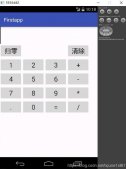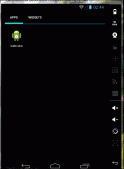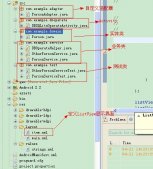本文实例讲述了Android开发自定义控件之折线图实现方法。分享给大家供大家参考,具体如下:
前言
折线图是Android开发中经常会碰到的效果,但由于涉及自定义View的知识,对许多刚入门的小白来说会觉得很高深。其实不然,接下来我就以尽量通俗的语言来说明下图折线图效果的实现过程。
效果图
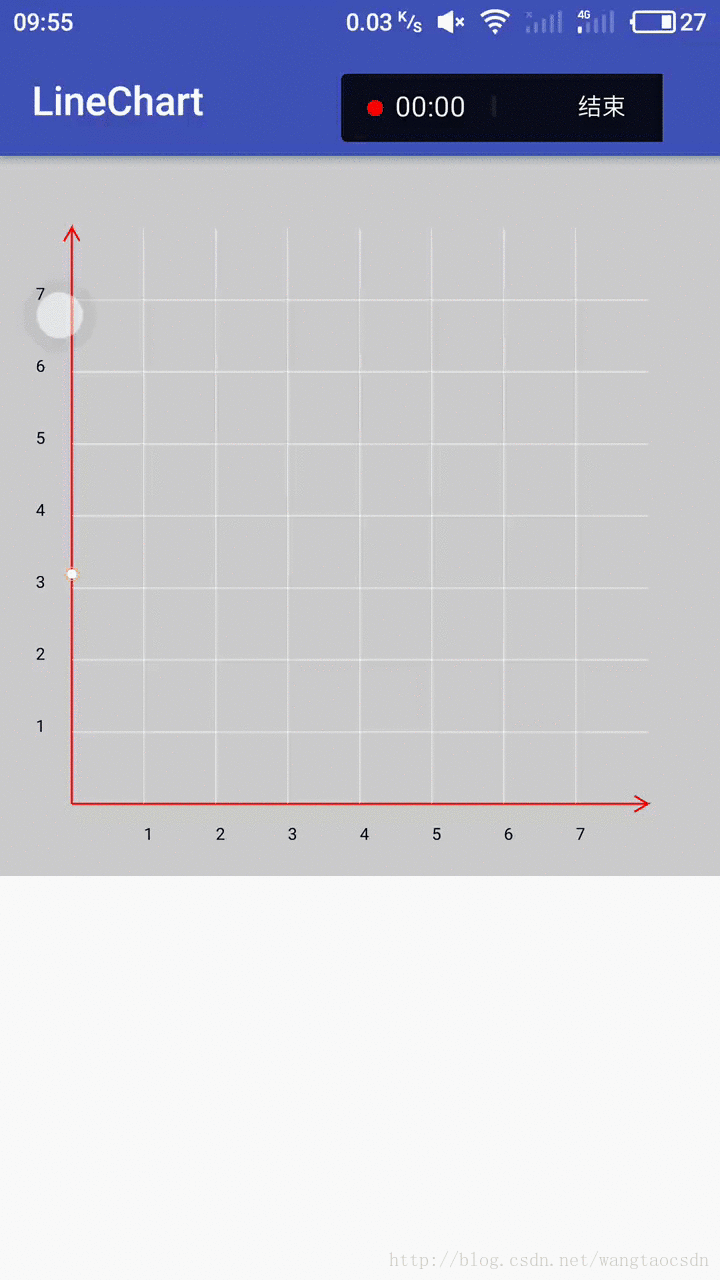
实现过程
首先,选择自定义控件的方式。
自定义控件的实现有四种方式:
1.继承View,重写onDraw、onMeasure等方法。
2.继承已有的View(比如TextView)。
3.继承ViewGroup实现自定义布局。
4.继承已有的ViewGroup(比如LinearLayout)。
由于我们不需要多个控件进行组合,也不需要在原有控件基础上改造,故我们采用第1种方式即继承View来实现。代码如下,新建一个ChartView类继承自View,并实现他的几个构造方法,并重写onDraw和onMeasure方法,因为我们要在onDraw方法里面进行绘制工作,并且我希望这个控件的长宽是相等的,所以在onMeasure方法设置宽高相等。设置长宽相等的方式很简单,我们不需要自己去测量实现,只需要调用父类的onMeasure方法,传参数(宽高值)时将都传入宽度(或者高度)即可。
|
1
2
3
4
5
6
7
8
9
10
11
12
13
14
15
16
17
18
19
20
21
22
23
24
|
public class ChartView extends View { public ChartView(Context context) { super(context); } public ChartView(Context context, @Nullable AttributeSet attrs) { super(context, attrs); } public ChartView(Context context, @Nullable AttributeSet attrs, int defStyleAttr) { super(context, attrs, defStyleAttr); } @Override protected void onMeasure(int widthMeasureSpec, int heightMeasureSpec) { super.onMeasure(widthMeasureSpec, widthMeasureSpec); } @Override protected void onDraw(Canvas canvas) { super.onDraw(canvas); }} |
其次,绘制简单图形并显示出来。
在进行绘制之前,我们要进行若干初始化工作,其中就包括画笔的初始化。然后就可以进行绘制了,我们先绘制一个简单的圆圈,然后将控件放到布局文件中,运行看看效果。
ChartView代码
|
1
2
3
4
5
6
7
8
9
10
11
12
13
14
15
16
17
18
19
20
21
22
23
24
25
26
27
28
29
30
31
32
33
34
35
36
37
38
39
40
41
42
43
44
45
46
47
48
49
50
51
52
53
54
55
56
57
58
59
60
61
|
public class ChartView extends View { // 画笔 private Paint paint; /** * 构造函数 */ public ChartView(Context context) { super(context); initWork(); } /** * 构造函数 */ public ChartView(Context context, @Nullable AttributeSet attrs) { super(context, attrs); initWork(); } /** * 构造函数 */ public ChartView(Context context, @Nullable AttributeSet attrs, int defStyleAttr) { super(context, attrs, defStyleAttr); initWork(); } /** * 初始化工作 */ private void initWork() { initPaint(); } /** * 画笔设置 */ private void initPaint() { paint = new Paint(Paint.ANTI_ALIAS_FLAG); // 画笔样式为填充 paint.setStyle(Paint.Style.FILL); // 颜色设为红色 paint.setColor(Color.RED); // 宽度为3像素 paint.setStrokeWidth(3); } @Override protected void onMeasure(int widthMeasureSpec, int heightMeasureSpec) { super.onMeasure(widthMeasureSpec, widthMeasureSpec); } @Override protected void onDraw(Canvas canvas) { super.onDraw(canvas); // 画圆 canvas.drawCircle(300,300,100,paint); }} |
activity_main.xml
|
1
2
3
4
5
6
7
8
9
10
11
|
<?xml version="1.0" encoding="utf-8"?><android.support.constraint.ConstraintLayout xmlns:android="http://schemas.android.com/apk/res/android" android:layout_width="match_parent" android:layout_height="match_parent" <com.toprs.linechart.ChartView android:layout_width="match_parent" android:layout_height="match_parent"/></android.support.constraint.ConstraintLayout> |
效果:
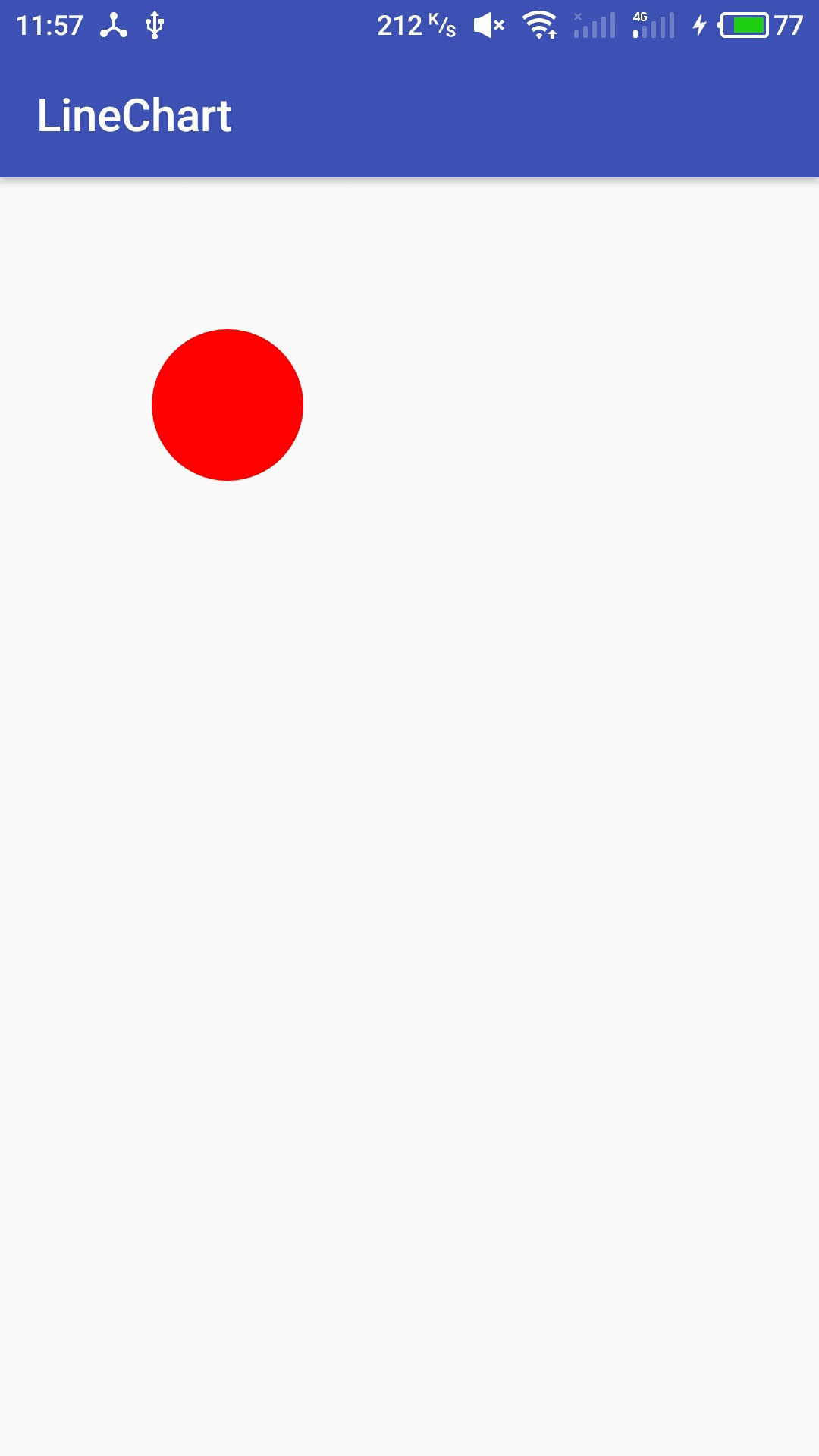
然后,绘制图表。
到目前为止,已经实现了最简单的一个自定义控件,虽然它什么功能都没有,只是简单显示一个红色圆圈,但本质都是一样的。接下来就开始图表的绘制。
1.初始化一些需要使用的值。
|
1
2
|
// 刻度之间的距离private int degreeSpace; |
|
1
2
3
4
5
6
7
8
9
10
11
12
13
14
15
16
17
18
19
20
21
22
|
@Overrideprotected void onDraw(Canvas canvas) { super.onDraw(canvas); // 控件上下左右边界四至及控件的宽度(同时也是高度!) int left = getLeft(); int right = getRight(); int top = getTop(); int bottom = getBottom(); int w = getWidth(); // 图表距离控件边缘的距离 int graphPadding = w / 10; // 图表上下左右四至 int graphLeft = left + graphPadding; int graphBottom = bottom - graphPadding; int graphRight = right - graphPadding; int graphTop = top + graphPadding; // 图表宽度(也等同高度奥~) int graphW = graphRight - graphLeft; // 刻度之间的距离 degreeSpace = graphW / 8;} |
2.灰色背景
|
1
2
|
// 背景canvas.drawColor(Color.LTGRAY); |
3.坐标系
|
1
2
3
4
5
6
7
8
9
10
11
12
13
14
15
16
17
18
19
20
|
// 画笔设置样式为STROKE样式,即只划线不填充paint.setStyle(Paint.Style.STROKE);// 坐标系绘制Path pivotPath = new Path();//Y轴pivotPath.moveTo(graphLeft, graphBottom);pivotPath.lineTo(graphLeft, graphTop);//Y轴箭头pivotPath.lineTo(graphLeft - 12, graphTop + 20);pivotPath.moveTo(graphLeft, graphTop);pivotPath.lineTo(graphLeft + 12, graphTop + 20);//X轴pivotPath.moveTo(graphLeft, graphBottom);pivotPath.lineTo(graphRight, graphBottom);//X轴箭头pivotPath.lineTo(graphRight - 20, graphBottom + 12);pivotPath.moveTo(graphRight, graphBottom);pivotPath.lineTo(graphRight - 20, graphBottom - 12);canvas.drawPath(pivotPath, paint); |
4.刻度虚线及数字
|
1
2
3
4
5
6
7
8
9
10
11
12
13
14
15
16
17
18
19
20
21
22
23
24
25
26
27
28
29
30
31
32
33
34
35
36
|
// Y轴刻度虚线for (int i = 1; i < 8; i++) { Path yKeduPath = new Path(); // 线 paint.setColor(Color.WHITE); paint.setStrokeWidth(1); paint.setStyle(Paint.Style.STROKE); paint.setPathEffect(new DashPathEffect(new float[]{5,5},0)); yKeduPath.moveTo(graphLeft, graphBottom - i * degreeSpace); yKeduPath.lineTo(graphRight, graphBottom - i * degreeSpace); canvas.drawPath(yKeduPath, paint); // 数字 paint.setColor(Color.BLACK); paint.setStyle(Paint.Style.FILL); paint.setTextSize(25); paint.setPathEffect(null); canvas.drawText(i + "", graphPadding / 2, graphBottom - i * degreeSpace, paint);}// X轴刻度虚线for (int i = 1; i < 8; i++) { Path xKeduPath = new Path(); // 线 paint.setColor(Color.WHITE); paint.setStyle(Paint.Style.STROKE); paint.setStrokeWidth(1); paint.setPathEffect(new DashPathEffect(new float[]{5,5},0)); xKeduPath.moveTo(graphLeft + i * degreeSpace, graphBottom); xKeduPath.lineTo(graphLeft + i * degreeSpace, graphTop); canvas.drawPath(xKeduPath, paint); // 数字 paint.setColor(Color.BLACK); paint.setStyle(Paint.Style.FILL); paint.setTextSize(25); paint.setPathEffect(null); canvas.drawText(i + "", graphLeft + i * degreeSpace, graphBottom + graphPadding / 2, paint);} |
5.折线
在绘制折线之前,我们先要初始化几个参数。
|
1
2
3
4
|
// 模拟数据private float[] data = {3.2f, 4.3f, 2.5f, 3.2f, 3.8f, 7.1f, 1.3f, 5.6f};// 当前显示的数据数量private int showNum=1; |
|
1
2
3
4
5
6
7
8
9
10
11
12
13
14
15
16
17
18
19
20
21
22
|
// 折线Path linePath = new Path();for (int i = 0; i < showNum; i++) { int toPointX = graphLeft + i * degreeSpace; int toPointY = graphBottom - ((int) (data[i] * degreeSpace)); paint.setColor(Color.YELLOW); paint.setStyle(Paint.Style.STROKE); if (i==0){ linePath.moveTo(toPointX,toPointY); }else { linePath.lineTo(toPointX, toPointY); } // 节点圆圈 canvas.drawCircle(toPointX, toPointY,10,paint); paint.setColor(Color.WHITE); paint.setStyle(Paint.Style.FILL); canvas.drawCircle(toPointX,toPointY,7,paint);}paint.setColor(Color.YELLOW);paint.setStyle(Paint.Style.STROKE);paint.setStrokeWidth(3);canvas.drawPath(linePath, paint); |
6.让图表动起来
为了实现数据依次显现的动画,我们开启一个线程是当前显示的数据数量即showNum变量不断加一,并间隔时间0.5秒。然后postInvalidate()重绘即可。
|
1
2
3
4
5
6
7
8
9
10
11
12
13
14
15
16
17
18
19
20
21
22
23
24
|
private void initWork() { initPaint(); // 开启线程,没隔0.5秒showNum加一 new Thread(new Runnable() { @Override public void run() { while (true){ if (showNum<data.length){ showNum++; }else { showNum=1; } // 重绘 postInvalidate(); // 休眠0.5秒 try { Thread.sleep(500); } catch (InterruptedException e) { e.printStackTrace(); } } } }).start();} |
好了,运行一下,便会实现上面的效果了。如果你觉得效果不够炫酷或者功能太少,那就自己完善吧~~
结语
由于自定义控件是Android进阶路上必然要碰到的知识,所以希望大家重视。其实自定义控件说难也难说简单也简单。实现一些普通的效果还是很方便的,像这次举的例子,但如果要实现各种炫酷效果并且要完善各种功能的话,就需要各种知识的配合了,包括数学、物理、绘图等知识。所以还是需要平时不断积累的,看到别人的控件很棒的时候自己可以试着去实现一下,对自己的知识库不断进行补充,自然会娴熟的运用。本人也是菜鸟一枚,望共勉!!
希望本文所述对大家Android程序设计有所帮助。
原文链接:https://blog.csdn.net/wangtaocsdn/article/details/73650462

